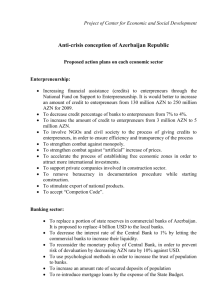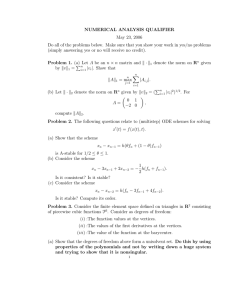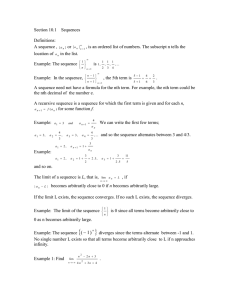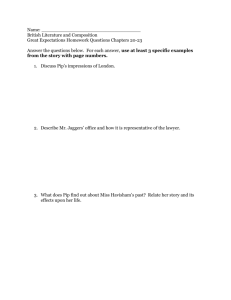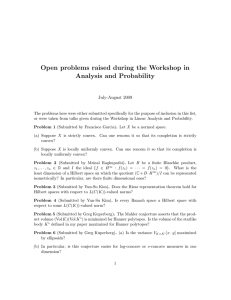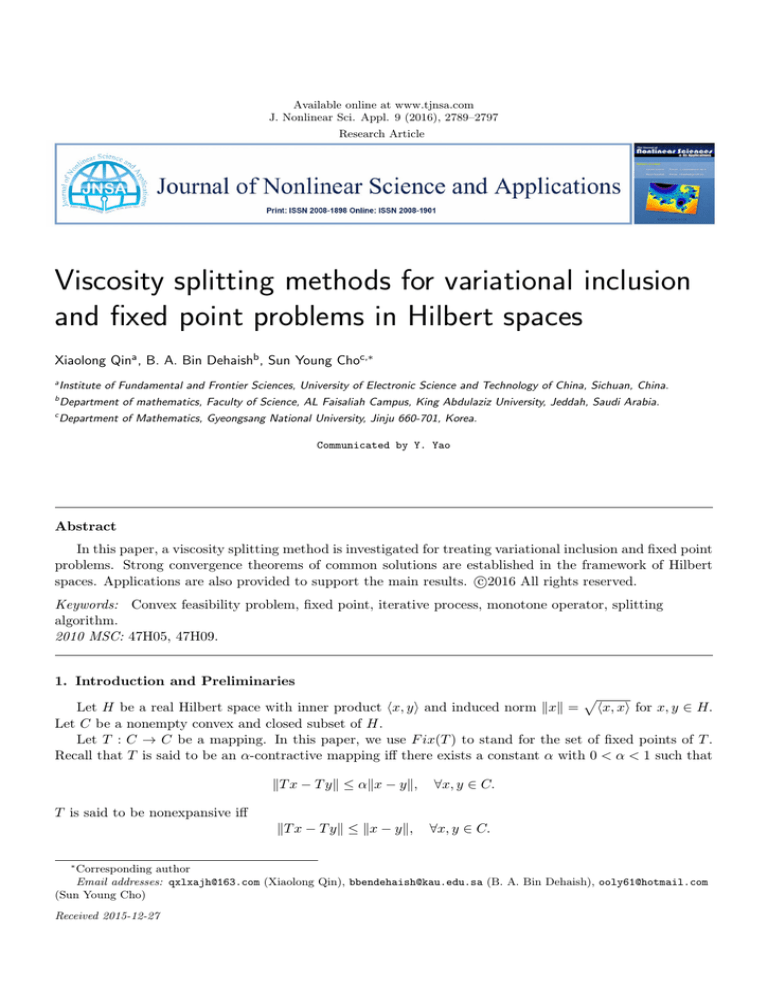
Available online at www.tjnsa.com
J. Nonlinear Sci. Appl. 9 (2016), 2789–2797
Research Article
Viscosity splitting methods for variational inclusion
and fixed point problems in Hilbert spaces
Xiaolong Qina , B. A. Bin Dehaishb , Sun Young Choc,∗
a
Institute of Fundamental and Frontier Sciences, University of Electronic Science and Technology of China, Sichuan, China.
b
Department of mathematics, Faculty of Science, AL Faisaliah Campus, King Abdulaziz University, Jeddah, Saudi Arabia.
c
Department of Mathematics, Gyeongsang National University, Jinju 660-701, Korea.
Communicated by Y. Yao
Abstract
In this paper, a viscosity splitting method is investigated for treating variational inclusion and fixed point
problems. Strong convergence theorems of common solutions are established in the framework of Hilbert
c
spaces. Applications are also provided to support the main results. 2016
All rights reserved.
Keywords: Convex feasibility problem, fixed point, iterative process, monotone operator, splitting
algorithm.
2010 MSC: 47H05, 47H09.
1. Introduction and Preliminaries
p
Let H be a real Hilbert space with inner product hx, yi and induced norm kxk = hx, xi for x, y ∈ H.
Let C be a nonempty convex and closed subset of H.
Let T : C → C be a mapping. In this paper, we use F ix(T ) to stand for the set of fixed points of T .
Recall that T is said to be an α-contractive mapping iff there exists a constant α with 0 < α < 1 such that
kT x − T yk ≤ αkx − yk,
∀x, y ∈ C.
T is said to be nonexpansive iff
kT x − T yk ≤ kx − yk,
∗
∀x, y ∈ C.
Corresponding author
Email addresses: qxlxajh@163.com (Xiaolong Qin), bbendehaish@kau.edu.sa (B. A. Bin Dehaish), ooly61@hotmail.com
(Sun Young Cho)
Received 2015-12-27
X. Qin, B. A. Bin Dehaish, S. Y. Cho, J. Nonlinear Sci. Appl. 9 (2016), 2789–2797
2790
If C is also bounded, then the set of fixed points of S is not empty; see [5] and the references therein. In the
real world, many important problems have reformulations which require finding fixed points of nonexpansive
mapping. Mann iteration is powerful to study fixed points of nonexpansive mappings. However it is only
weakly convergent. Recently, many authors studied the problem of modifying Mann iteration so that strong
convergence is guaranteed without any compactness assumption; see [7, 8, 12, 13, 14, 16, 24, 25, 26, 27] and
the references therein.
T is said to be a λ-strict pseudocontraction iff there exists a constant λ with 0 ≤ λ < 1 such that
kT x − T yk2 ≤ kx − yk + λkx − T x − y + T yk2 ,
∀x, y ∈ C.
The class of λ-strict pseudocontractions was introduced by Browder and Petryshyn [6] in 1967. It is clear
that the class of λ-strict pseudocontractions strictly include the class of nonexpansive mappings as a special
cases. It is also known that every λ-strict pseudocontraction is Lipschitz continuous; see [6] and the references
therein.
Let A : C → H be a mapping. Recall that A is said to be monotone iff
hAx − Ay, x − yi ≥ 0,
∀x, y ∈ C.
A is said to be λ-strongly monotone iff there exists a positive constant λ > 0 such that
hAx − Ay, x − yi ≥ λkx − yk2 ,
∀x, y ∈ C.
A is said to be inverse λ-strongly monotone iff there exists a positive constant λ > 0 such that
hAx − Ay, x − yi ≥ λkAx − Ayk2 ,
∀x, y ∈ C.
From the above, we see that A is inverse λ-strongly monotone iff A−1 is strongly monotone. A is said to be
L-Lipschitz continuous iff there exists a positive constant L > 0 such that
kAx − Ayk ≤ Lkx − yk,
∀x, y ∈ C.
It is obvious that A is inverse λ-strongly monotone, then A is also monotone and
Recall that the classical variational inequality is to find an x ∈ C such that
hAx, y − xi ≥ 0,
∀y ∈ C.
1
λ -Lipschitz
continuous.
(1.1)
The solution set of variational inequality (1.1) is denoted by V I(C, A). Projection methods have been
recently investigated for solving variational inequality (1.1). Let P rojC be the metric projection from
H onto C and I the identity on H. It is known that x is a solution to (1.1) iff x is a fixed point of
mapping P rojC (I − rA). If A is inverse λ-strongly monotone, then P rojC (I − rA) is nonexpansive. If C is
bounded, closed and convex, then the existence of solutions of variational inequality (1.1) is guaranteed by
the nonexpansivity of mapping P rojC (I − rA).
Recall that an operator B : H ⇒ H is said to be monotone iff, for all x, y ∈ H, f ∈ Bx and g ∈ By
imply hx − y, f − gi ≥ 0. In this paper, we use B −1 (0) to stand for the zero point of B. A monotone
mapping B : H ⇒ H is maximal iff the graph G(B) of B is not properly contained in the graph of any
other monotone mapping. It is known that a monotone mapping B is maximal if and only if, for any
(x, f ) ∈ H × H, hx − y, f − gi ≥ 0, for all (y, g) ∈ G(B) implies f ∈ Bx. For a maximal monotone operator
B on H, and r > 0, we may define the single-valued resolvent JrB = (I + rB)−1 , where D(B) denote
the domain of B. It is known that JrB : H → D(B) is firmly nonexpansive, and B −1 (0) = F ix(JrB ). The
property of the resolvent ensures that the Picard iterative algorithm xn+1 = JrB xn converge weakly to a
fixed point of JrB , which is necessarily a zero point of B. Rockafellar introduced this iteration method and
call it the proximal point algorithm (PPA); for more detail, see [20, 23] and the references therein. The
PPA and its dual version in the context of convex programming, the method of multipliers of Hesteness and
X. Qin, B. A. Bin Dehaish, S. Y. Cho, J. Nonlinear Sci. Appl. 9 (2016), 2789–2797
2791
Powell, have been extensively studied and are known to yield as special cases decomposition methods such
as the method of partial inverses [22], the Douglas-Rachford splitting method, and the alternating direction
method of multipliers [10]. In the case of B = B1 + B2 , where B1 and B2 are maximal monotone on H,
the forward-backward splitting method xn+1 = (I + rn B1 )−1 (I − rn B2 )xn , n = 0, 1, · · · , where rn > 0,
was proposed by Lions and Mercier [15], and in a dual form for convex programming, by Han and Lou
[11]. In the case where B1 = NC , this method reduces to a projection method proposed by Sibony [21] for
monotone variational inequalities (1.1). Recently, many authors have studied the splitting algorithm; see
[2, 3, 4, 9, 17, 18, 19] and the references therein.
In this paper, a viscosity splitting method is investigated for treating a inclusion problem with two
monotone operators and a fixed point problem of λ-strict pseudocontractions. Strong convergence theorems
of common solutions are established in the framework of Hilbert spaces. Applications are also provided to
support the main results.
The following lemmas are essential to prove our main results.
Lemma 1.1 ([3]). Let C be a nonempty convex and closed subset of a real Hilbert space H. Let A : C → H
be a mapping, and B : H ⇒ H a maximal monotone operator. Then F (Jr (I − rA)) = (A + B)−1 (0).
Lemma 1.2 ([25]). Let {an } be a sequence of nonnegative numbers satisfying the condition an+1
P∞≤ (1 −
tn )an + tn bn + cn , ∀n ≥ 0, where {tn } is a number sequence in (0, 1) such that limn→∞ tn = 0 and n=0 tn =
∞, {b
Pn } is a number sequence such that lim supn→∞ bn ≤ 0, and {cn } is a positive number sequence such
that ∞
n=0 cn < ∞. Then limn→∞ an = 0.
Lemma 1.3 ([1]). Let Hbe a Hilbert
space,
and A an maximal monotone operator. For λ > 0, µ > 0, and
µ
µ
x ∈ E, we have Jλ x = Jµ λ x + 1 − λ Jλ x , where Jλ = (I + λA)−1 and Jµ = (I + µA)−1 .
Lemma 1.4 ([6]). Let C be a nonempty convex and closed subset of a real Hilbert space H. Let T : C → C
be a λ-strict pseudocontraction. Define a mapping S by S = βI + (1 − β)T . If beta ∈ [λ, 1), then S is
nonexpansive and F ix(T ) = F ix(S).
Lemma 1.5 ([6]). Let C be a nonempty convex and closed subset of a real Hilbert space H. Let T : C → C
be a λ-strict pseudocontraction. Then T is Lipschitz continuous and I − T is demiclosed at zero.
2. Main results
Theorem 2.1. Let C be a nonempty convex closed subset of a real Hilbert space H. Let A : C → H be an
inverse κ-strongly monotone mapping and let B be a maximal monotone operator on H. Let f : C → C be a
fixed α-contraction and let T : C → C be a λ-strict pseudocontraction. Assume that (A + B)−1 (0) ∩ F ix(T )
is not empty. Let {αn }, {βn } be real number sequences in (0, 1) and let {rn } be a real number sequence in
(0, 2κ). Let {xn } be a sequence in C generated in the following process: x0 ∈ C, xn+1 = βn yn + (1 − βn )T yn ,
−1
∀n ≥ 0, where
{yn } is a sequence in C such that kyn − (I + rn B) αn f (xn ) + (1 − αn )xn − rn A αn f (xn ) +
(1
− αn )xn k ≤Pen . Assume that the control sequences satisfy the
following restrictions: P
limn→∞ αn = 0,
P∞
P∞
∞
0
αn = ∞, n=1 |αn − αn−1 | < ∞, 0 < a ≤ rn ≤ a < 2κ, n=1 |rn − rn−1 | < ∞, ∞
n=0 ken k < ∞,
Pn=0
∞
00 < 1, where a, a0 and a00 are three real numbers. Then {x }
|β
−
β
|
<
∞,
and
λ
≤
β
≤
a
n−1
n
n
n=1 n
converges strongly to a point x̄ ∈ F ix(T ) ∩ (A + B)−1 (0), where x̄ = P rojF ix(T )∩(A+B)−1 (0) f (x̄), that is, x̄
solves the following variational inequality hf (x̄) − x̄, x̄ − xi ≥ 0, ∀x ∈ F ix(T ) ∩ (A + B)−1 (0).
Proof. Since A is inverse κ-strongly monotone, one has
k(I − rn A)x − (I − rn A)yk2 = kx − yk2 − 2rn hx − y, Ax − Ayi + rn 2 kAx − Ayk2
≤ kx − yk2 − rn (2κ − rn )kAx − Ayk2 .
From the restriction imposed on {rn }, one has I − rn A is nonexpansive. Setting Tn = βn I + (1 − βn )T,
X. Qin, B. A. Bin Dehaish, S. Y. Cho, J. Nonlinear Sci. Appl. 9 (2016), 2789–2797
2792
where I is the identity, one sees from Lemma 1.4 that Tn is nonexpansive with F ix(Tn ) = F ix(T ). Fixing
p ∈ F ix(T ) ∩ (A + B)−1 (0), one has from Lemma 1.1 that p = Tn p = (I + rn B)−1 (p − rn Ap). Setting
zn = αn f (xn ) + (1 − αn )xn , one has
kzn − pk ≤ αn kf (xn ) − pk + (1 − αn )kxn − pk
≤ 1 − αn (1 − α) kxn − pk + αn kf (p) − pk.
Hence, one has
kxn+1 − pk ≤ kyn − pk
≤ kyn − (I + rn B)−1 zn − rn Azn k + k zn − rn Azn − p − rn Ap k
≤ kzn − pk + en
≤ 1 − αn (1 − α) kxn − pk + αn kf (p) − pk + en
kf (p) − pk
≤ max{kxn − pk,
} + en .
1−α
By mathematical induction, one finds that sequence {xn } is bounded, so are {yn } and {zn }. Notice that
kzn − zn−1 k ≤ |αn − αn−1 |kxn−1 − f (xn−1 )k + 1 − αn (1 − α) kxn−1 − xn k.
(2.1)
Putting wn = zn − rn Azn , we find from (2.1) that
kwn − wn−1 k ≤ kzn − zn−1 k + krn − rn−1 kkAzn−1 k
≤ |αn − αn−1 |kxn−1 − f (xn−1 )k + 1 − αn (1 − α) kxn−1 − xn k
(2.2)
+ |rn − rn−1 |kAzn−1 k.
Set JrBn = (I + rn B)−1 . Using Lemma 1.3, one has
kxn − xn+1 k = kTn−1 yn−1 − Tn yn k
≤ kyn−1 − yn k + |βn − βn−1 |kyn − T yn k
≤ kJrBn wn − JrBn−1 wn−1 k + |βn − βn−1 |kyn − T yn k + en−1 + en
rn−1
rn−1
≤ k(1 −
)(JrBn wn − wn−1 ) +
(wn − wn−1 )k
rn
rn
+ |βn − βn−1 |kyn − T yn k + en−1 + en
rn−1
)(JrBn wn − wn ) + (wn − wn−1 )k
≤ k(1 −
rn
+ |βn − βn−1 |kyn − T yn k + en−1 + en
|rn − rn−1 |
≤
kwn − JrBn wn k + kwn−1 − wn k
rn
+ |βn − βn−1 |kyn − T yn k + en−1 + en .
(2.3)
Combining (2.2) with (2.3), one has
kxn − xn+1 k ≤
|rn − rn−1 |
kwn − JrBn wn k + |αn − αn−1 |kxn−1 − f (xn−1 )k
rn
+ 1 − αn (1 − α) kxn−1 − xn k + |rn − rn−1 |kAzn−1 k
+ |βn − βn−1 |kyn − T yn k + en−1 + en .
Using the restrictions imposed on {rn }, {en }, {αn } and {βn } and Lemma 1.1, we find limn→∞ kxn −xn+1 k =
0. Since αn → 0 as n → ∞, we find
lim kxn − zn k = 0.
(2.4)
n→∞
X. Qin, B. A. Bin Dehaish, S. Y. Cho, J. Nonlinear Sci. Appl. 9 (2016), 2789–2797
2793
Since k · k2 is convex, we have
kzn − pk2 ≤ αn kf (xn ) − pk2 + (1 − αn )kxn − pk2
≤ kxn − pk2 + αn kf (xn ) − pk2 .
This in turn implies
kxn+1 − pk2 ≤ kyn − JrBn (zn − rn Azn )k2 + kJrBn (zn − rn Azn ) − pk2
+ 2kJrBn (zn − rn Azn ) − pkkyn − JrBn (zn − rn Azn )k
≤ k(zn − rn Azn ) − (p − rn Ap)k2 + 2en kJrBn (zn − rn Azn ) − pk + e2n
≤ kzn − pk2 − rn (2κ − rn )kAzn − Apk2 + 2en kzn − pk + e2n
≤ kxn − pk2 + αn kf (xn ) − pk2 − rn (2κ − rn )kAzn − Apk2 + 2en kzn − pk + e2n .
It follows that
rn (2κ − rn )kAzn − Apk2 ≤ kxn − pk2 + αn kf (xn ) − pk2 − kxn+1 − pk2 + (2kzn − pk + en )en .
Therefore, one finds
lim kAp − Azn k = 0.
n→∞
(2.5)
Since JrBn is firmly nonexpansive, one has
kJrBn (zn − rn Azn ) − pk2 ≤ h(zn − rn Azn ) − (p − rn Ap), JrBn (zn − rn Azn ) − pi
1
k(zn − rn Azn ) − (p − rn Ap)k2 + kJrBn (zn − rn Azn ) − pk2
≤
2
− kzn − JrBn (zn − rn Azn ) − rn (Azn − Ap)k2 .
It follows that
kJrBn (zn − rn Azn ) − pk2 ≤ kzn − pk2 − kzn − JrBn (zn − rn Azn )k2
− rn kAzn − Apk2 + 2rn kzn − JrBn (zn − rn Azn )kkAzn − Apk.
Hence, one has
kxn+1 − pk2 ≤ kyn − JrBn (zn − rn Azn )k2 + kJrBn (zn − rn Azn ) − pk2
+ 2kJrBn (zn − rn Azn ) − pkkyn − JrBn (zn − rn Azn )k
≤ kJrBn (zn − rn Azn ) − pk2 + en (2kJrBn (zn − rn Azn ) − pk + en )
≤ kzn − pk2 − kzn − JrBn (zn − rn Azn )k2
+ 2rn kzn − JrBn (zn − rn Azn )kkAzn − Apk
+ en (2kJrBn (zn − rn Azn ) − pk + en )
≤ kxn − pk2 + αn kf (xn ) − pk2 − kzn − JrBn (zn − rn Azn )k2
+ 2rn kzn − JrBn (zn − rn Azn )kkAzn − Apk
+ en (2kJrBn (zn − rn Azn ) − pk + en ),
which further implies from (2.5)
lim kzn − JrBn (zn − rn Azn )k = 0.
n→∞
(2.6)
X. Qin, B. A. Bin Dehaish, S. Y. Cho, J. Nonlinear Sci. Appl. 9 (2016), 2789–2797
2794
Since Tn is nonexpansive, one has
kβn xn + (1 − βn )T xn − xn k ≤ kβn xn + (1 − βn )T xn − βn yn − (1 − βn )T yn k
+ kxn − βn yn − (1 − βn )T yn k
≤ kxn − yn k + kxn − xn+1 k
≤ kxn − zn k + kzn − JrBn (zn − rn Azn )k + kxn − xn+1 k + en .
In view of (2.4) and (2.6), one has limn→∞ kβn xn + (1 − βn )T xn − xn k = 0. Note that
kT xn − xn k ≤ kT xn − βn xn − (1 − βn )T xn k + kβn xn + (1 − βn )T xn − xn k
≤ βn kxn − T xn k + kβn xn + (1 − βn )T xn − xn k.
From the restriction imposed on sequence {βn }, one finds that limn→∞ kT xn − xn k = 0.
Next, we show that
lim suphf (x̄) − x̄, zn − x̄i ≤ 0,
(2.7)
n→∞
where x̄ is the unique fixed point of the mapping P roj(A+B)−1 (0)∩F ix(T ) f. To show this inequality, we choose
a subsequence {zni } of {zn } such that
lim suphf (x̄) − x̄, zn − x̄i = lim hf (x̄) − x̄, zni − x̄i ≤ 0.
n→∞
i→∞
Since {zni } is bounded, we find that there exists a subsequence {znij } of {zni } which converges weakly to x̂.
Without loss of generality, we assume that zni * x̂. Putting µn = JrBn (zn − rn Azn ), we find that µni * x̂.
Next, we show x̂ ∈ (A + B)−1 (0). Notice that zn − rn Azn ∈ µn + rn Bµn ; that is,
zn − rn Azn − µn
∈ Bµn .
rn
Let µ ∈ Bν. Since B is maximal monotone, we find
zn − µ n
− Azn − µ, µn − ν ≥ 0.
rn
It follows that h−Ax̂ − µ, x̂ − νi ≥ 0. This in turn implies that −Ax̂ ∈ B x̂, that is, x̂ ∈ (A + B)−1 (0).
Now, we are in a position to show that x̂ is also in F ix(T ). Since xni * x̂, we find from Lemma 1.5 that
x̂ ∈ F ix(T ) immediately. This proves that (2.7) holds.
Finally, we show that {xn } converges strongly to x̄, where x̄ is the unique fixed point of mapping
P roj(A+B)−1 (0)∩F ix(T ) f.
Note that
kzn − x̄k2 ≤ αn hf (x̄) − x̄, zn − x̄i + 1 − αn (1 − α) kzn − x̄kkxn − x̄k.
It follows that kzn − x̄k2 ≤ 2αn hf (x̄) − x̄, zn − x̄i + 1 − αn (1 − α) kxn − x̄k2 . Hence, one has
kxn+1 − x̄k2 ≤ kyn − x̄k2
≤ kJrBn (zn − rn Azn ) − x̄k2 + en (2kJrBn (zn − rn Azn ) − x̄k + en )
≤ kzn − x̄k2 + en (2kJrBn (zn − rn Azn ) − x̄k + en )
≤ 2αn hf (x̄) − x̄, zn − x̄i + 1 − αn (1 − α) kxn − x̄k2
+ en (2kJrBn (zn − rn Azn ) − x̄k + en ).
An application of Lemma 1.2 to the above inequality yields that limn→∞ kxn − x̄k = 0. This completes the
proof.
X. Qin, B. A. Bin Dehaish, S. Y. Cho, J. Nonlinear Sci. Appl. 9 (2016), 2789–2797
2795
From Theorem 2.1, the following results are not hard to derive.
Corollary 2.2. Let C be a nonempty convex closed subset of a real Hilbert space H. Let A : C → H be an
inverse κ-strongly monotone mapping and let B be a maximal monotone operator on H. Let f : C → C be
a fixed α-contraction and let T : C → C be a nonexpansive mapping. Assume that (A + B)−1 (0) ∩ F ix(T )
is not empty. Let {αn }, {βn } be real number sequences in (0, 1) and let {rn } be a real number sequence in
(0, 2κ). Let {xn } be a sequence in C generated in the following process: x0 ∈ C, xn+1 = βn yn + (1 − βn )T yn ,
−1
∀n ≥ 0, where
{yn } is a sequence in C such that kyn − (I + rn B) αn f (xn ) + (1 − αn )xn − rn A αn f (xn ) +
(1
− αn )xn k ≤Pen . Assume that the control sequences satisfy the
following restrictions: P
limn→∞ αn = 0,
P∞
P∞
∞
0
αn = ∞, n=1 |αn − αn−1 | < ∞, 0 < a ≤ rn ≤ a < 2κ, n=1 |rn − rn−1 | < ∞, ∞
n=0 ken k < ∞,
Pn=0
∞
00 < 1, where a, a0 and a00 are three real numbers. Then {x }
|β
−
β
|
<
∞,
and
0
≤
β
≤
a
n−1
n
n
n=1 n
converges strongly to a point x̄ ∈ F ix(T ) ∩ (A + B)−1 (0), where x̄ = P rojF ix(T )∩(A+B)−1 (0) f (x̄), that is, x̄
solves the following variational inequality hf (x̄) − x̄, x̄ − xi ≥ 0, ∀x ∈ F ix(T ) ∩ (A + B)−1 (0).
Corollary 2.3. Let C be a nonempty convex closed subset of a real Hilbert space H. Let A : C → H be an
inverse κ-strongly monotone mapping and let B be a maximal monotone operator on H. Let f : C → C be
a fixed α-contraction. Assume that (A + B)−1 (0) is not empty. Let {αn }, {βn } be real number sequences
in (0, 1) and let {rn } be a real number sequence in (0, 2κ). Let x0 ∈ C and {xn
} be a sequence in C such
that kxn+1 − (I + rn B)−1 αn f (xn ) + (1 − αn )xn − rn A αn f (xn ) +P
(1 − αn )xn k P
≤ en . Assume that the
∞
control sequences satisfy P
the following restrictions:Plimn→∞ αn = 0, n=0 αn = ∞, ∞
n=1 |αn − αn−1 | < ∞,
∞
0 are three real numbers.
ke
k
<
∞,
where
a
and
a
|r
−
r
|
<
∞,
0 < a ≤ rn ≤ a0 < 2κ, ∞
n
n−1
n=0
n=1 n
Then {xn } converges strongly to a point x̄ ∈ (A + B)−1 (0), where x̄ = P roj(A+B)−1 (0) f (x̄), that is, x̄ solves
the following variational inequality hf (x̄) − x̄, x̄ − xi ≥ 0, ∀x ∈ (A + B)−1 (0).
Let C be a nonempty closed and convex subset of a Hilbert space H. Let iC be the indicator function
of C, that is,
(
0,
x ∈ C,
iC (x) =
∞, x ∈
/ C.
Since iC is a proper lower and semicontinuous convex function on H, the subdifferential ∂iC of iC is maximal
monotone. So, we can define the resolvent Jr∂iC of ∂iC for r > 0, i.e., Jr∂iC := (I+r∂iC )−1 . Letting x = Jr∂iC y,
we find that
y ∈ x + r∂iC x ⇐⇒ y ∈ x + rNC x
⇐⇒ hy − x, v − xi ≤ 0, ∀v ∈ C
⇐⇒ x = P rojC y,
where P rojC is the metric projection from H onto C and NC x := {e ∈ H : he, v − xi, ∀v ∈ C}.
From Theorem 2.1, we have the following results on variational inequality (1.1).
Corollary 2.4. Let C be a nonempty convex closed subset of a real Hilbert space H. Let A : C → H be
an inverse κ-strongly monotone mapping. Let f : C → C be a fixed α-contraction and let T : C → C
be a λ-strict pseudocontraction. Assume that V I(C, A) ∩ F ix(T ) is not empty. Let {αn }, {βn } be real
number sequences in (0, 1) and let {rn } be a real number sequence in (0, 2κ). Let {xn } be a sequence in C
generated in the following process: x0 ∈ C, xn+1 = βn yn + (1 − βn )T yn , ∀n ≥ 0,where {yn } is a sequence
in C such that kyn − P rojC αn f (xn ) + (1 − αn )xn − rn A αn f (xn ) +
− αn )xn kP≤ en . Assume that the
P(1
∞
∞
control sequences satisfy
the
following
restrictions:
lim
α
=
0,
n→∞
n
n=0 αn = ∞,
n=1 |αn − αn−1 | < ∞,
P∞
P∞
P∞
0
0 < a ≤ rn ≤ a < 2κ, n=1 |rn −rn−1 | < ∞, n=0 ken k < ∞, n=1 |βn −βn−1 | < ∞, and λ ≤ βn ≤ a00 < 1,
where a, a0 and a00 are three real numbers. Then {xn } converges strongly to a point x̄ ∈ F ix(T ) ∩ V I(C, A),
where x̄ = P rojF ix(T )∩V I(C,A) f (x̄), that is, x̄ solves the following variational inequality hf (x̄) − x̄, x̄ − xi ≥ 0,
∀x ∈ F ix(T ) ∩ V I(C, A).
X. Qin, B. A. Bin Dehaish, S. Y. Cho, J. Nonlinear Sci. Appl. 9 (2016), 2789–2797
2796
Acknowledgements
This article was supported by the National Natural Science Foundation of China under grant
No.11401152.
References
[1] V. Barbu, Nonlinear semigroups and differential equations in Banach spaces, Translated from the Romanian,
Editura Academiei Republicii Socialiste România, Bucharest; Noordhoff International Publishing, Leiden (1976).
1.3
[2] H. H. Bauschke, A note on the paper by Eckstein and Svaiter on general projective splitting methods for sums of
maximal monotone operators, SIAM J. Control Optim., 48 (2009), 2513–2515. 1
[3] B. A. Bin Dehaish, A. Latif, H. O. Bakodah, X. Qin, A viscosity splitting algorithm for solving inclusion and
equilibrium problems, J. Inequal. Appl., 2015 (2015), 14 pages. 1, 1.1
[4] B. A. Bin Dehaish, X. Qin, A. Latif, H. O. Bakodah, Weak and strong convergence of algorithms for the sum of
two accretive operators with applications, J. Nonlinear Convex Anal., 16 (2015), 1321–1336. 1
[5] F. E. Browder, Nonexpansive nonlinear operators in a Banach space, Proc. Nat. Acad. Sci. U.S.A, 54 (1965),
1041–1044. 1
[6] F. E. Browder, W. V. Petryshyn, Construction of fixed points of nonlinear mappings in Hilbert space, J. Math.
Anal. Appl., 20 (1967), 197–228. 1, 1.4, 1.5
[7] S. Y. Cho, Generalized mixed equilibrium and fixed point problems in a Banach space, J. Nonlinear Sci. Appl., 9
(2016), 1083–1092. 1
[8] S. Y. Cho, X. Qin, On the strong convergence of an iterative process for asymptotically strict pseudocontractions
and equilibrium problems, Appl. Math. Comput., 235 (2014), 430–438. 1
[9] S. Y. Cho, X. Qin, L. Wang, Strong convergence of a splitting algorithm for treating monotone operators, Fixed
Point Theory Appl., 2014 (2014), 15 pages. 1
[10] J. Eckstein, D. P. Bertsekas, On the Douglas-Rachford splitting method and the proximal point algorithm for
maximal monotone operators, Math. Programming, 55 (1992), 293–318. 1
[11] S. P. Han, G. Lou, A parallel algorithm for a class of convex programs, SIAM J. Control Optim., 26 (1988),
345–355. 1
[12] J. K. Kim, S. Y. Cho, X. Qin, Some results on generalized equilibrium problems involving strictly pseudocontractive
mappings, Acta Math. Sci. Ser. B Engl. Ed., 31 (2011), 2041–2057. 1
[13] J. K. Kim, G. S. Saluja, Convergence of composite implicit iterative process with errors for asymptotically nonexpansive mappings in Banach spaces, Nonlinear Funct. Anal. Appl., 18 (2013), 145–162. 1
[14] Y. Kimura, Shrinking projection methods for a family of maximal operators, Nonlinear Funct. Anal. Appl., 16
(2011), 481–489. 1
[15] P. L. Lions, B. Mercier, Splitting algorithms for the sum of two nonlinear operators, SIAM J. Numer. Anal., 16
(1979), 964–979. 1
[16] B. Liu, C. Zhang, Strong convergence theorems for equilibrium problems and quasi-φ-nonexpansive mappings,
Nonlinear Funct. Anal. Appl., 16 (2011), 365–385. 1
[17] X. Qin, S. Y. Cho, L. Wang, Iterative algorithms with errors for zero points of m-accretive operators, Fixed Point
Theory Appl., 2013 (2013), 17 pages. 1
[18] X. Qin, S. Y. Cho, L. Wnag, A regularization method for treating zero points of the sum of two monotone
operators, Fixed Point Theory Appl., 2014 (2014), 10 pages. 1
[19] X. Qin, S. Y. Cho, L. Wang, Convergence of splitting algorithms for the sum of two accretive operators with
applications, Fixed Point Theory Appl., 2014 (2014), 12 pages. 1
[20] R. T. Rockfellar, Augmented Lagrangians and applications of the proximal point algorithm in convex programming,
Math. Oper. Res., 1 (1976), 97–116. 1
[21] M. Sibony, Méthodes itératives pour les équations et inéquations aux dérivées partielles nonlinéares de type monotone, (French), Calcolo, 7 (1970), 65–183. 1
[22] J. E. Spingarn, Applications of the method of partial inverses to convex programming: decomposition, Math.
Programming, 32 (1985), 199–223. 1
[23] M. V. Solodov, B. F. Svaiter, Forcing strong convergence of proximal point iterations in a Hilbert space, Math.
Program., 87 (2000), 189–202. 1
[24] G. Wang, S. Sun, Hybrid projection algorithms for fixed point and equilibrium problems in a Banach space, Adv.
Fixed Point Theory, 3 (2013), 578–594. 1
[25] Z. Q. Xue, H. Y. Zhou, Y. J. Cho, Iterative solutions of nonlinear equations for m-accretive operators in Banach
spaces, J. Nonlinear Convex Anal., 1 (2000), 313–320. 1, 1.2
[26] Y. Yao, Y. J. Cho, Y. C. Liou, Iterative algorithms for variational inclusions, mixed equilibrium problems and
fixed point problems approach to optimization problems, Central European J. Math., 9 (2011), 640–656. 1
X. Qin, B. A. Bin Dehaish, S. Y. Cho, J. Nonlinear Sci. Appl. 9 (2016), 2789–2797
2797
[27] Y. Yao, M. A. Noor, S. Zainab, Y. C. Liou, Mixed equilibrium problems and optimization problems, J. Math.
Anal. Appl., 354 (2009), 319–329. 1

